When thinking of Idaho and plants, most people think of potatoes since the state grows more than ⅓ of all the U.S. potatoes. You can find much more than spuds in the northwestern state of Idaho. Also called the Gem State, Idaho is mountainous, with farmlands and plenty of rivers. Like other regions in America, its landscape is home to a diverse array of flora. Here you will find 12 native plants in Idaho, and interesting things to learn about.

The creation of oxygen with the use of photosynthesis is one of the main benefits plants offer. Some plants give food to animals or provide shade and shelter. Others showcase their pristine beauty, while some plants may be more nefarious and have toxic properties. Let’s look at 12 native plants in Idaho that you may come across, which are just a few of the thousands of plants in the state.
1. Sacajawea Bitterroot (Lewisia sacajawea)

Sacajawea bitterroot has thick succulent-like leaves.
©Edna Rey-Vizgirdas / public domain – License
The Sacajawea bitterroot is a flowering plant native to Idaho. It has only been observed in central Idaho’s mountain range in elevations of 5,000 to 9,500 feet. This plant is similar looking to the queen’s cup lily but can be differentiated by the white flower that blooms and its long green leaves. The Sacajawea bitterroot has thick succulent-like leaves and a quarter-sized white flower that blooms shortly after the snow melts. About 75% of the Sacajawea bitterroot can be found in the Boise National Forest.
2. Indian Hemp (Apocynum cannabinum)
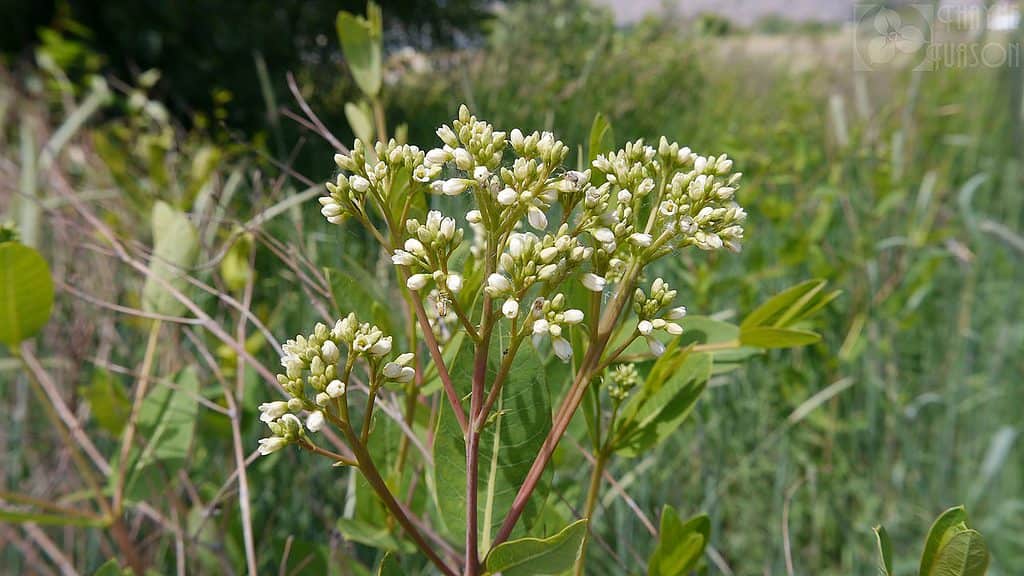
All parts of Indian hemp are toxic to humans.
©Thayne Tuason / CC BY 4.0, , via Wikimedia Commons – License
Indian hemp, also known as dogbane, prairie dogbane, or hemp dogbane, is a poisonous plant found all over North America. This plant has reddish brown stems that contain milky white latex and long oval leaves. During the months of July and August, this plant blooms small cream-colored flowers in clusters at the end of branches. Every part of this plant is toxic to humans and animals and can cause cardiac arrest when ingested. Near low-elevation wetlands are where Indian hemp is seen most.
3. Sagebrush (Artemisia)
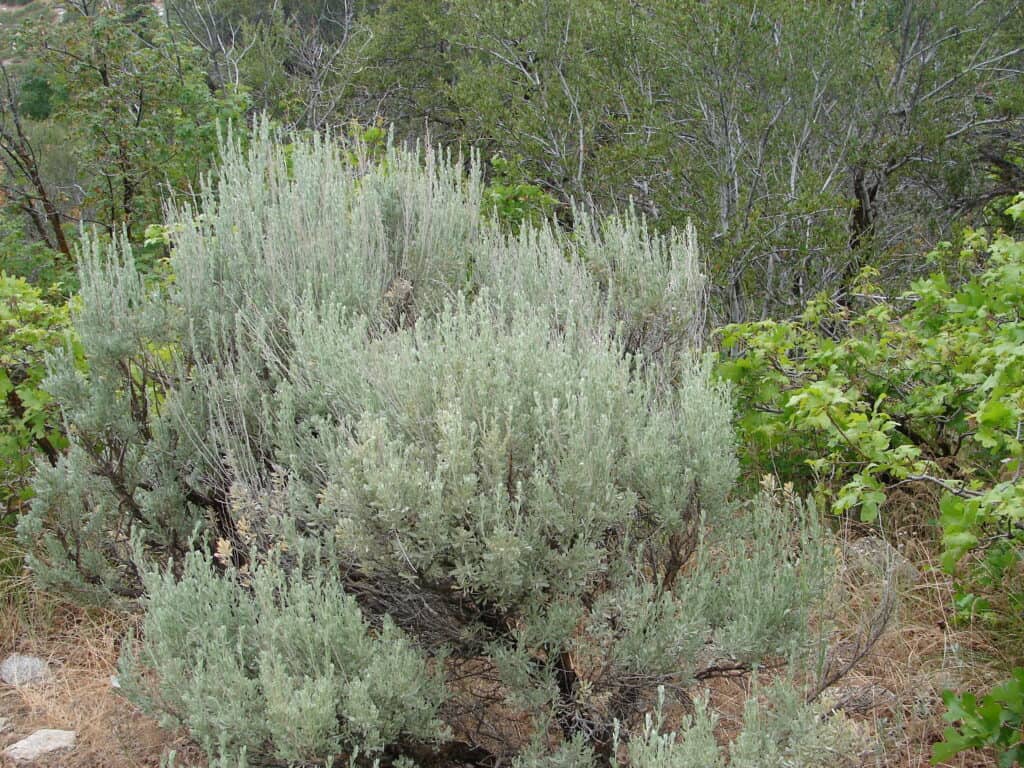
The sagebrush is an important source of food for animals like cattle.
©Kathryn Roach/Shutterstock.com
Sagebrush is an iconic plant that can be found in Idaho and other western regions in North America. In Idaho, you can find up to 36 different types of sagebrush species. This plant grows best in deserts, mountains, steppes, and semi-arid places.
Sagebrush is an important source of food for animals like cattle or sheep. This plant is very important in the habitats they live in, as they provide food and homes for the animals that live near it. The aromatic plant is used as a nesting ground for birds like the greater sage grouse. The loss of this plant’s habitat may occur due to wildfires, and climate change.
4. Prairie flax (Linum lewisii)
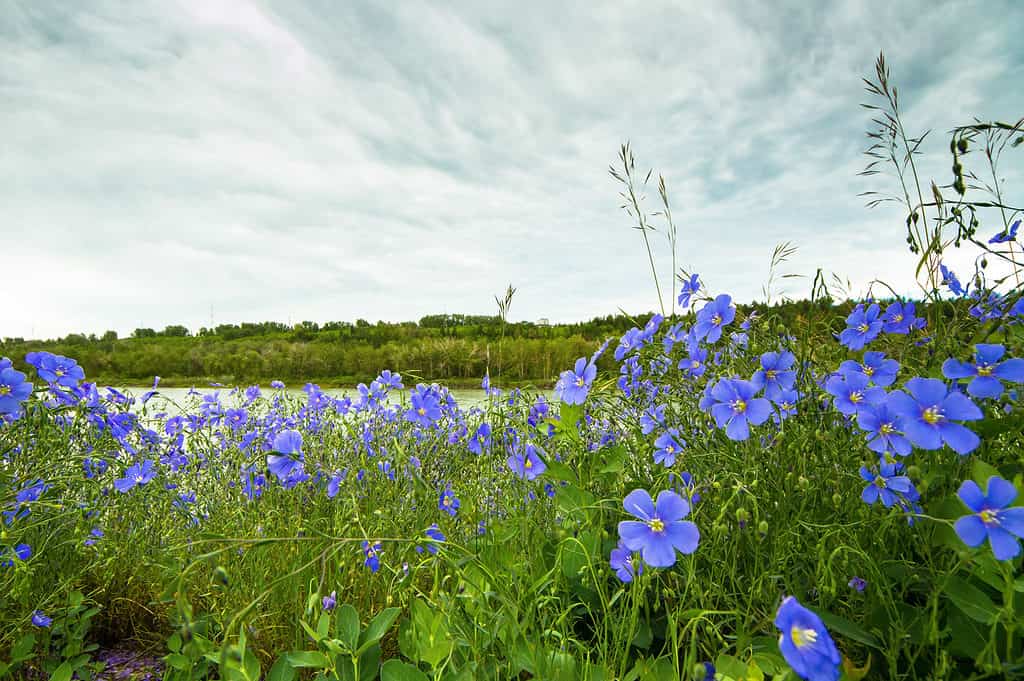
The prairie flax can grow aggressively in the right conditions.
©SWP222/Shutterstock.com
The prairie flax is one of the many plant species that are native to Idaho. This perennial grows up to 18 to 20 inches large. They are mainly found in the western region of the United States. Blooming occurs in the late spring and mid-summer. One stem from this plant can produce several flowers, which have a dark blue coloring and five petals on them.
Prairie flax flowers are a very durable species and can grow aggressively in the right conditions. In the past, native American cultures used the prairie flax plant to cook, and the plant was eaten for the nutritional qualities they were thought to have. When young, the prairie flax may have a bushy appearance. On the sides of dry slopes, and ridges are where the prairie flax is spotted most often.
5. Huckleberry (Vaccinium membranaceum)
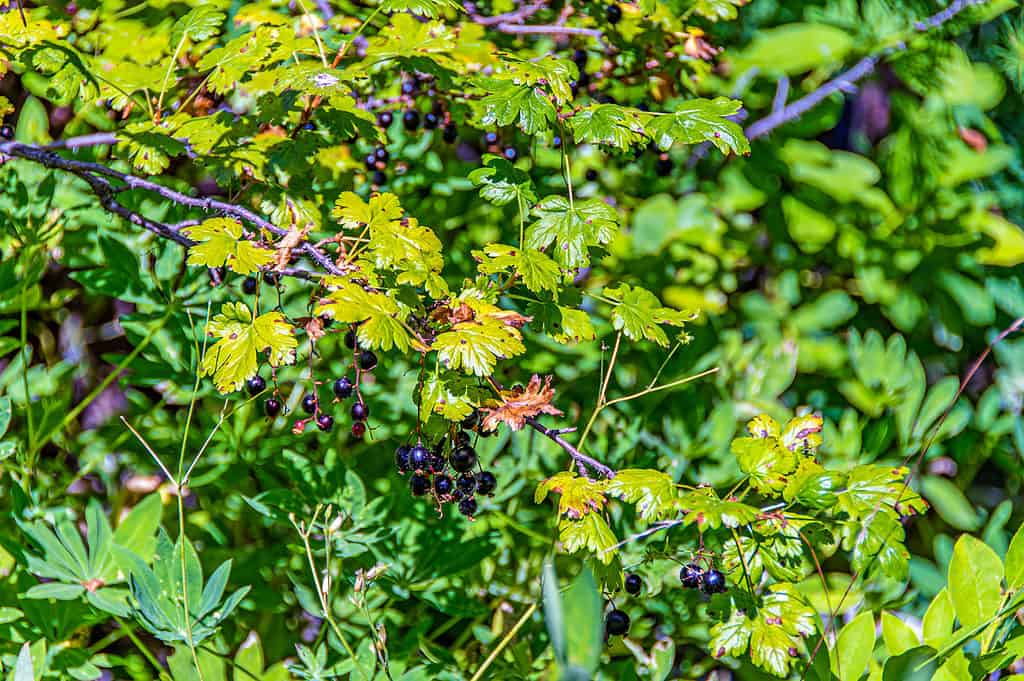
The huckleberry is the state’s official fruit for Idaho.
©iStock.com/MarciParavia
In Idaho, the most common type of huckleberry is the black huckleberry, but in the state, you can find several species native to the area. The year 2000 is when legislation was officially passed to make the huckleberry the state fruit. This plant grows at high elevations between 2,000 to 11,000 feet and is most abundant in elevations between 4,000 to 6,000 feet above sea level.
Vaccinium membranaceum is also called the thin-leaf huckleberry, tall huckleberry, and mountain huckleberry. This shrub grows up to 4.9 ft. tall, and is famous for the large amounts of fruit they produce. Bears, elks, and deer are some of the animals that rely on this plant for food. Huckleberries in Idaho are mainly found in the Rocky Mountains and Pacific Northwest areas in the state.
6. Fairy Slipper (Calypso bulbosa)
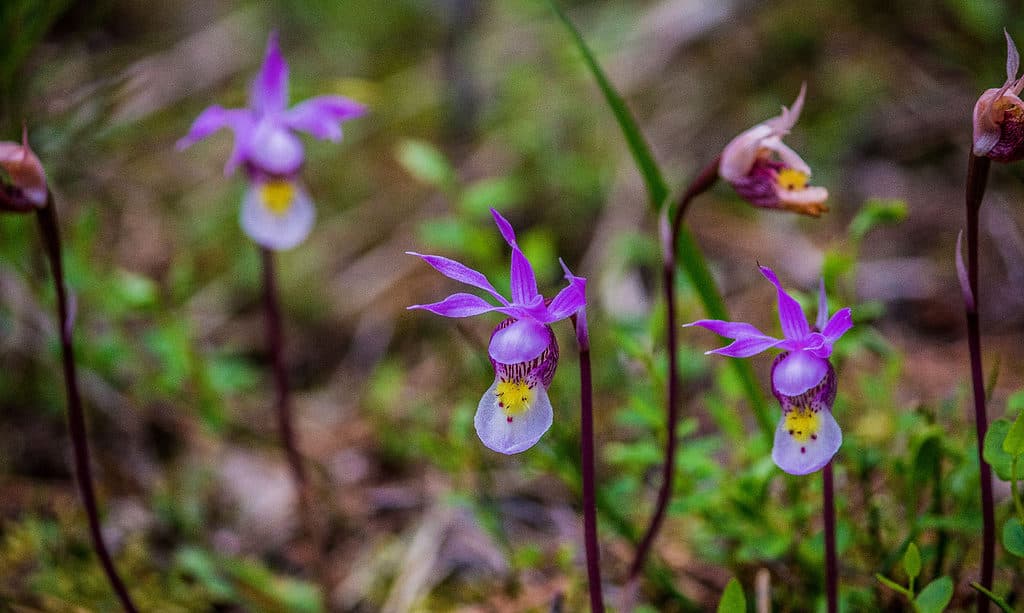
Fairy slippers have egg-shaped leaves and slender stems.
©jennifer dahlen/Shutterstock.com
Woodlands and wet boggy forests are the areas the fairy slipper grows, preferring shaded areas. This plant is a perennial in the orchid family. They grow between 3 to 8 inches in height and only have a single flower that grows from their base. The lips of this flower are pinkish, and they have a pouch shape. Fairy slippers have egg-shaped leaves and slender stems.
Blooming does not occur for this flower until May and June. The individual bulbs can live for around 5 years. Fairly slippers are found mainly in the western United States, and Canada. In Idaho, this plant is not seen often since it requires specific living conditions.
7. Queen’s Cup Lily (Clintonia uniflora)
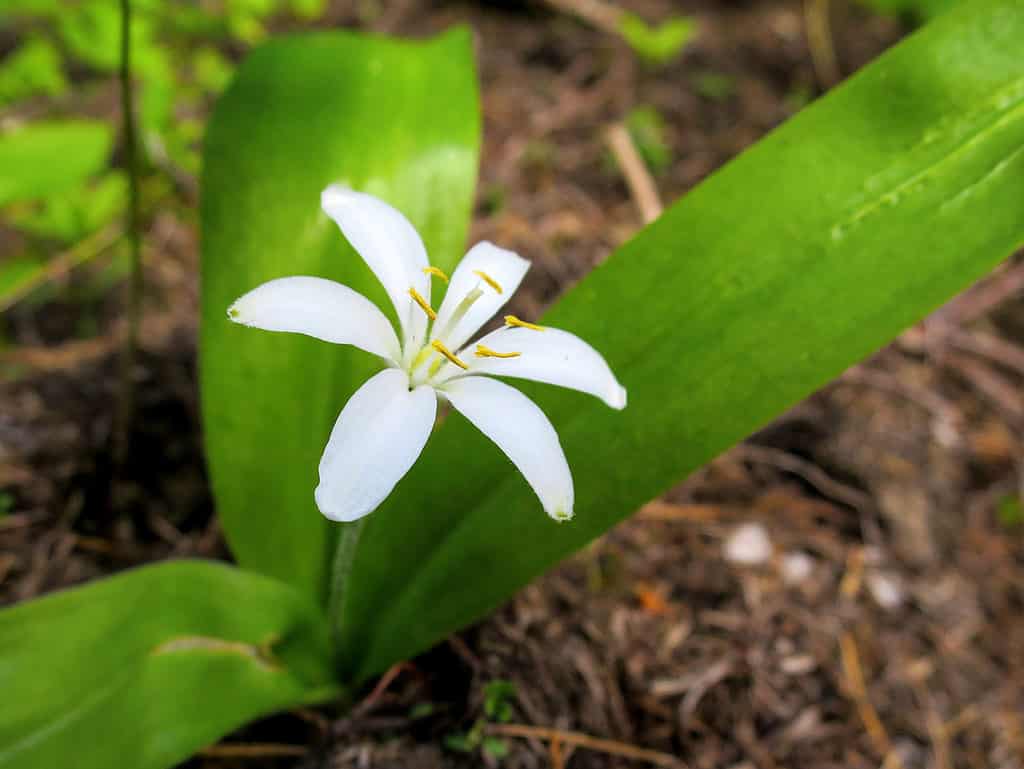
Queen’s Cup lilies distribution covers Idaho and the western region of North America.
©iStock.com/randimal
The queen’s cup lily is a plant native to Idaho, found in shaded woodlands and along streams with other vegetation. The bride’s bonnet and bead lily are other names this plant species goes by. Queen’s cup lilies are members of the Liliaceae family and are a flowering species. Compared to other plants in their genus, this species is the smallest, only growing between 6 to 10 inches tall.
At the base of its stem are two to three leaves that grow up to 3 inches large. Plants usually have a single white flower, but some may have two. Queen’s Cup lilies distribution covers Idaho and the western region of North America. Historically, this plant was used as medicine for indigenous people. Animals will not typically eat this plant unless there is a lack of other food. May through July is when their white flowers begin to bloom.
8. Bluebunch Wheatgrass (Pseudoroegneria spicata)
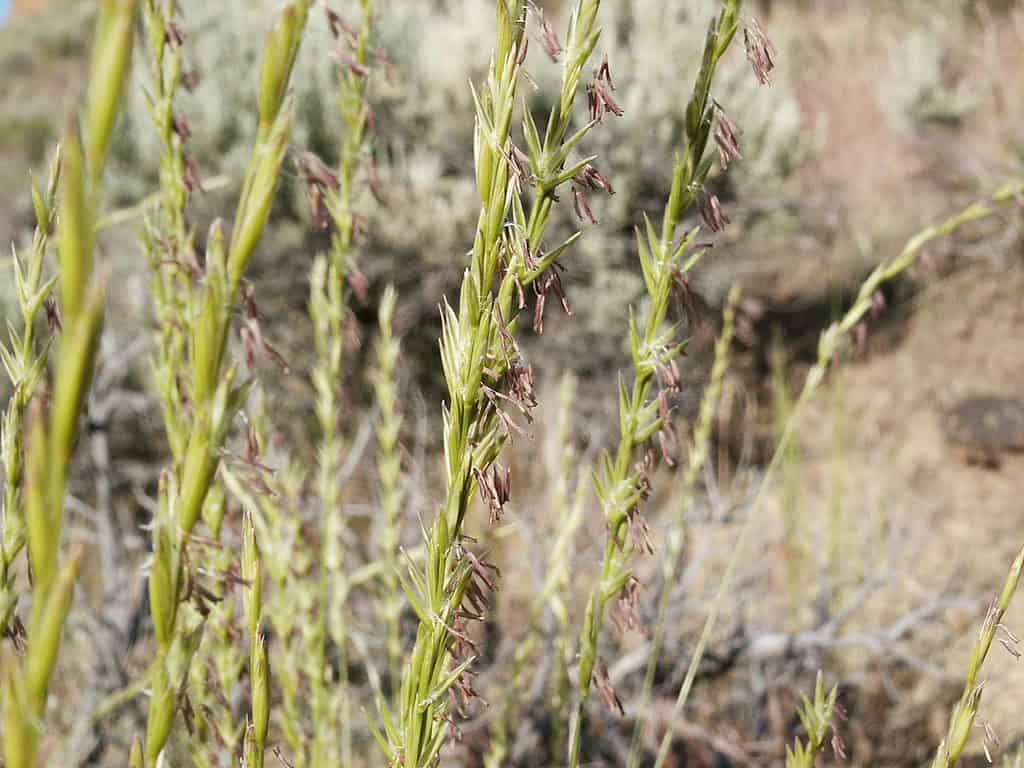
Bluebunch wheatgrass has a simple green and yellowish appearance.
©T9500 / public domain – License
The western United States, including Idaho, is where the bluebunch wheatgrass can be found. This grass may look very simple and plain, but it plays an important role in Idaho’s ecosystem. Bluebunch wheatgrass has a simple green and yellowish appearance. It looks like a large clump of grass that grows out of the ground. This plant grows between 1.5 to 4 feet in height, and the seed spikes on them range between 3 to 8 inches.
Bluebunch wheatgrass typically grows in open woodlands and sagebrush habitats. The roots can grow more than 6 feet in the ground, which helps them obtain water and survive better in drier climates. Animals like deer and elk rely on this food as a valuable resource. This plant is a long-living species, and primarily uses its seed to reproduce, but not in rainfall.
9. Beaked Hazelnut (Corylus cornuta)
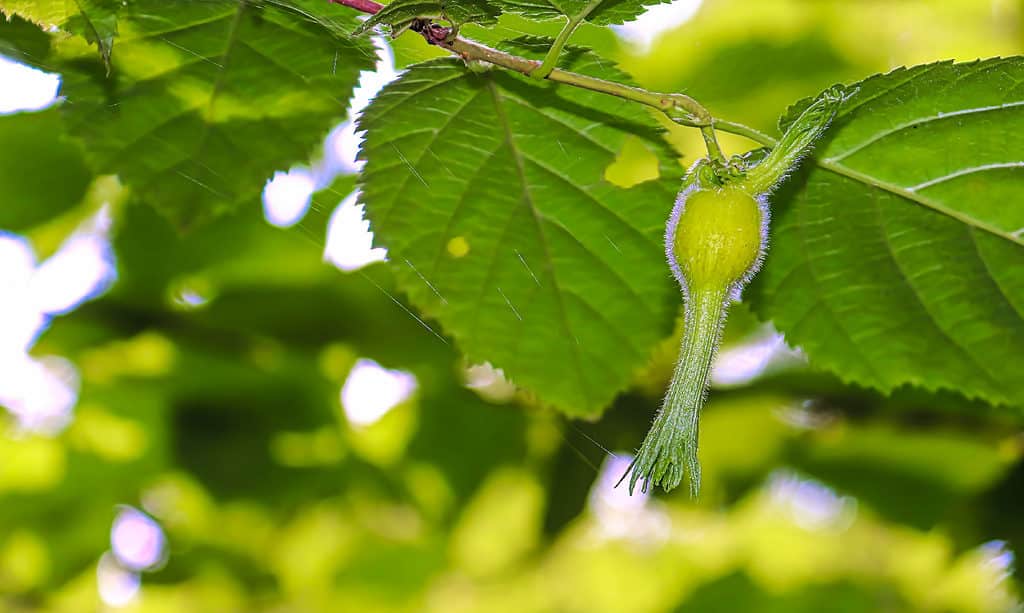
Baked hazelnut are hardy species.
©iStock.com/Akchamczuk
The beaked hazelnut is a deciduous shrub that is native to Idaho and is found in most of North America. This plant grows between 13 to 26 feet tall, and its name comes from the fruit that they produce. The foliage of this plant is dark green, with its leaves turning yellow in the fall. Bushes of this species have been known to live up to 40 years in commercial settings.
Idaho is one of the many places where this highly adaptable plant lives, and they are a hardy species tolerable against things like pollution. Blooming for this plant occurs in the spring, and fall is typically when they begin to bear fruit. Humans and animals both enjoy the fruits this plant produces. Open forests and edged woodland habitats are where beaked hazelnuts grow most in the wild.
10. Wild Strawberry (Fragaria virginiana)
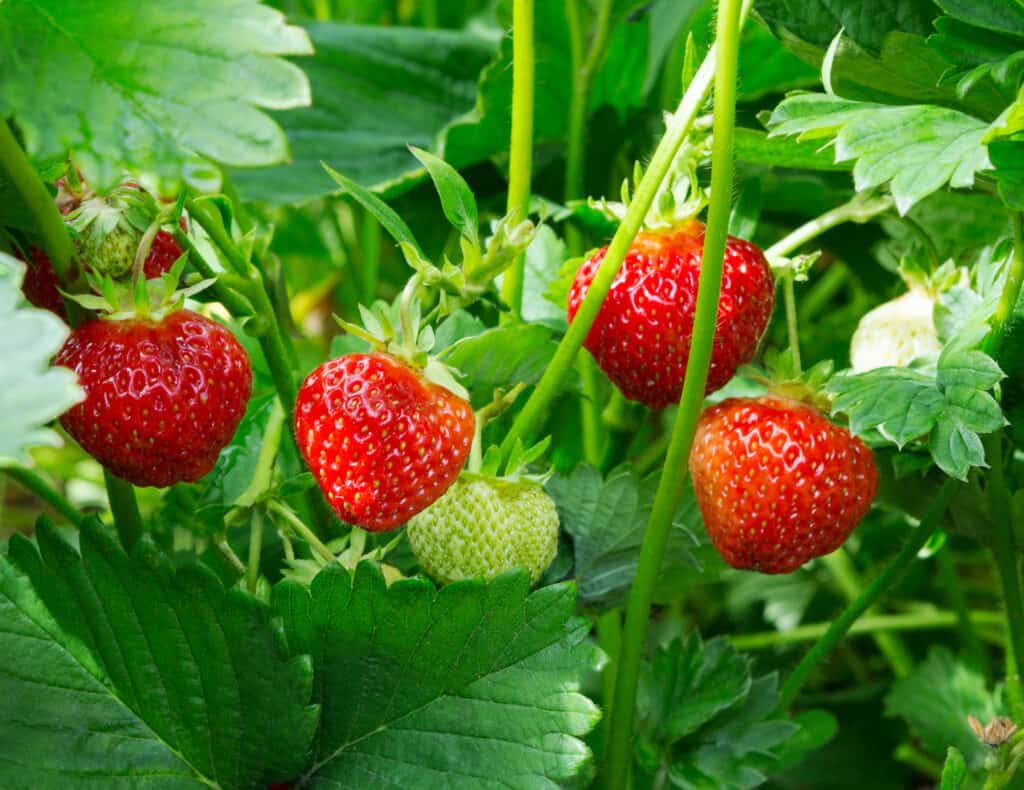
Strawberry leaves have serrated edges.
©iStock.com/romiri
Out of the different strawberry plant species that grow in North America, the wild strawberry is the most widespread. This plant is native to Idaho, and it is one of the strawberry plant species that was hybridized to create the garden strawberry. Wild strawberries can grow very quickly and have a large range that covers the majority of the United States.
When grown, the wild strawberry plant reaches around 4 inches in height. They lie low to the ground, and the plant is made up of trifoliate leaves. The fruit that this plant produces is small and bright red in color. The ability to spread quickly is why wild strawberries are found in most places. Compared to other strawberry plants, this species seems to be more resistant to disease. Animals like chipmunks, birds, and deer are some of the animals in Idaho that benefit from fruit that bloom from the months of April to June.
11. Western White Pine (Pinus monticola)

The cones found on western white pine trees are slender.
©Sunshine Haven Photo/Shutterstock.com
The western white pine is Idaho’s state tree, and this large pine is exclusive to the North Rockies Eco-region within the state. Growing relatively fast, western white pines obtain a height of 175 feet and have a thickness ranging from 5 to 8 feet. The pine needles of this tree are dark bluish-green. Western white pines have a conical shape and are made up of slender needles put in bunches of five. Their bark is thick, and their name comes from their woods’ yellowish-white coloring.
In the past, it was common to find forests of this tree that were 200 years of age or older. Within the last 40 years, the population of this tree has declined by around 93%. Diseases, invasive insects, climate change, and fires are the main reasons for the native plant’s decline in Idaho. Western white pines have been regularly planted in an attempt to conserve them and rebound their population.
12. Syringa (Philadelphus lewisii)
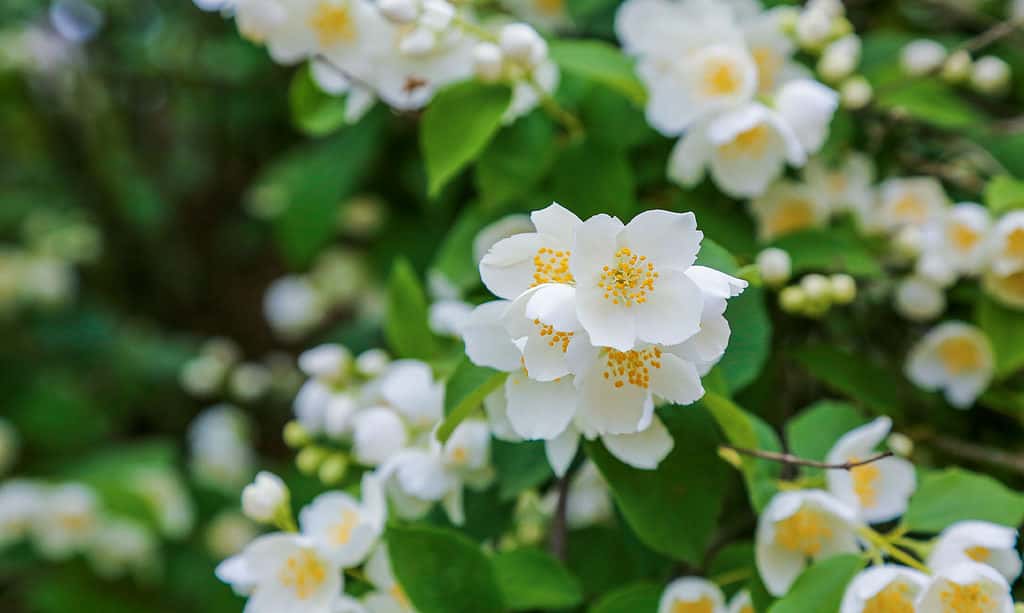
Syringa is the state flower of Idaho.
©iStock.com/Olesya Boltenkova
Not only is the syringa a native plant to Idaho, but it is also the state flower, designated that title in 1931. This plant is a perennial shrub that tends to reach 4 to 10 feet in height. The flowers on this shrub bloom in the spring months and have a white color like snow. Their petals are waxy, and their stamens are bright yellow. Syringa flowers grow together in clusters, and they have a smell similar to orange blossoms.
This shrub is most common in medium to dry soil near streams, rocky areas, and on hillsides. You can find this plant most often in the Boise National Forest, and the canyons around the Anderson Ranch Reservoir. Animals like quails, elk, and deer may use this plant to feed off their seeds and foliage. Native Americans also used this plant to create various items like arrows, combs, and pipe stems.
Summary of 12 Native Plants in Idaho
| Native Plant | Fun Fact | |
|---|---|---|
| 1 | Sacajawea Bitterroot | Blooms right after the snow melts |
| 2 | Indian Hemp | Every part of this plant is toxic and can cause death to humans and pets |
| 3 | Sagebrush | This iconic plant of arid regions is an important food source for cattle and sheep |
| 4 | Prairie flax | The dark blue flowers of this plant add vivid color to the prairie |
| 5 | Huckleberry | The fruit of this wild shrub is a favorite of deer, bears, and humans |
| 6 | Fairy Slipper | This perennial is a member of the orchid family |
| 7 | Queen’s Cup Lily | This delicate white lily grows along streams and in woodlands |
| 8 | Bluebunch Wheatgrass | Roots of this plant grow up to 6 feet underground – enabling the plant to survive in dryer climates |
| 9 | Beaked Hazelnut | Humans and animals enjoy the fruit of this lovely plant |
| 10 | Wild Strawberry | Wild strawberries are favorites of deer and chipmunks |
| 11 | Western White Pine | Idaho’s state tree features slender cones |
| 12 | Syringa | Idaho’s state flower has waxy white flowers that smell like orange blossoms |
The photo featured at the top of this post is © iStock.com/kornyeyeva
Sources
- Native Plants in Idaho , Available here: https://www.nature.org/en-us/about-us/where-we-work/united-states/idaho/stories-in-idaho/native-plants/
- Native Plants Program , Available here: https://www.blm.gov/programs/natural-resources/native-plant-communities/about-native-plants/idaho
- Idaho State Flower, Available here: https://statesymbolsusa.org/symbol-official-item/idaho/state-flower/syringa
- Idaho State Emblems , Available here: https://sos.idaho.gov/emblems/#:~:text=The%20Syringa%20(Philadelphus%20lewisii)%20was,the%20plant%20in%20his%20journal.
Thank you for reading! Have some feedback for us? Contact the AZ Animals editorial team.






